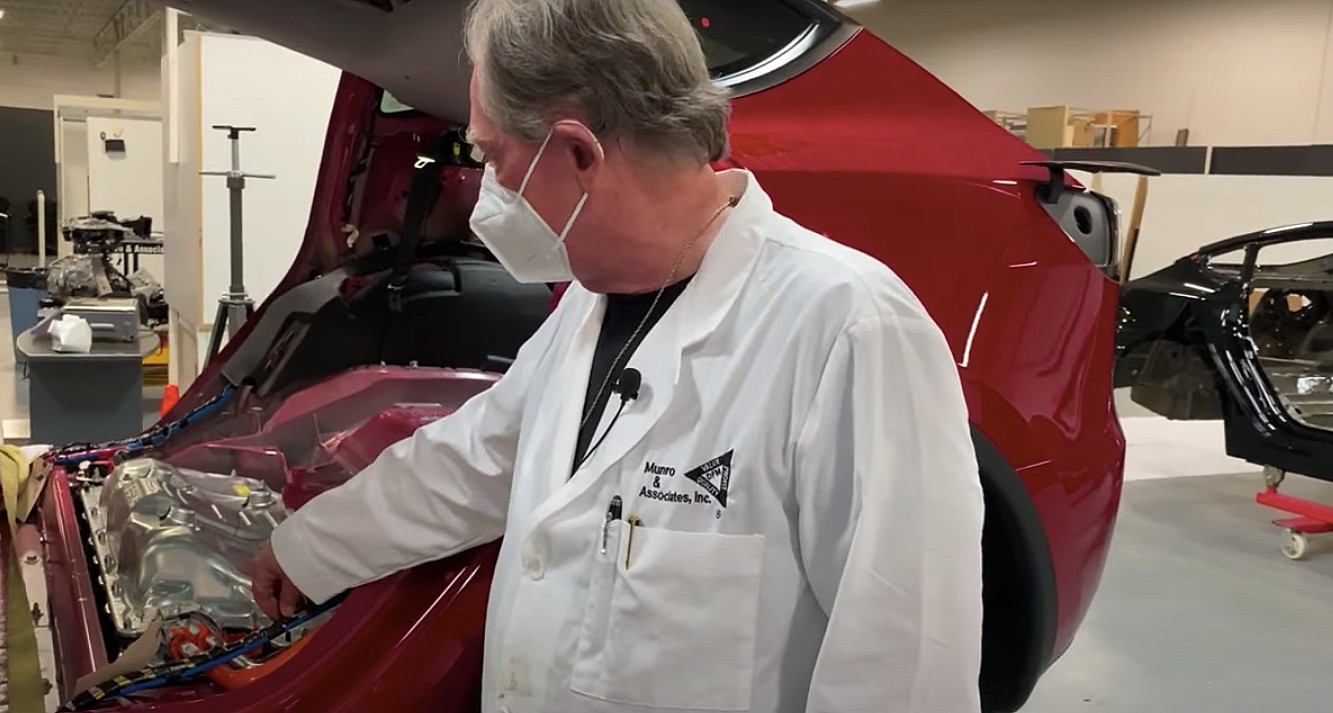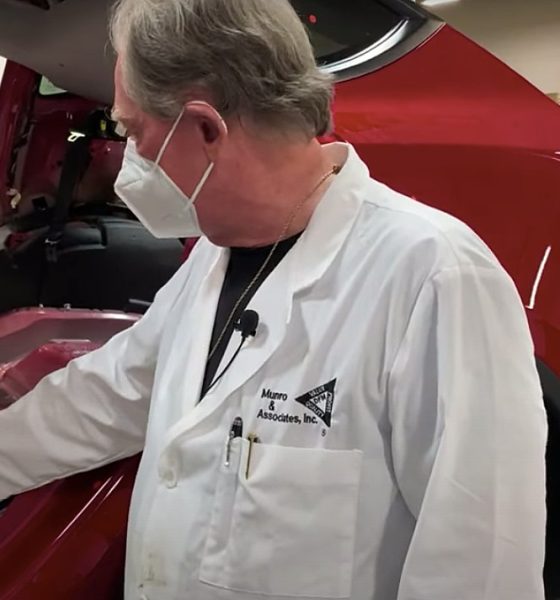

News
Tesla Model Y wiring efficiencies questioned in latest Munro teardown
Sandy Munro took the opportunity to show the Tesla Model Y’s new wiring structure, however, the Detroit automotive veteran noted to be “kind of disappointed” in some of its design.
“What I see here is a nice application of the wire troughs and candy striping…But unfortunately, there’s just as many wires; the wires are just as long,” Munro said.
In July 2019, Tesla published a patent that aimed to improve the wiring, power, and communications systems for its vehicles by reducing the amount of wires found within a car. The idea for a new wiring architecture was needed as many miles of cables can be located within a vehicle, all of which need to be installed by humans and not by machines. The installation of these power lines can take a significant amount of time when needed in excessive lengths. Thus, Tesla maintained it would be decreased from 1.5 kilometers of wire in the Model 3 to just 100 meters in the Model Y.
A Tesla vehicle’s wiring system is responsible for powering everything from turn signals and interior lights to the vehicle’s charging system. It consists of both 12-volt and 400-volt wiring, and the length of wiring needed varies from vehicle to vehicle. However, one thing remains consistent: efficient wiring is crucial for faster production speeds. However, a reduction of wiring also can contribute to reducing the vehicle’s weight as miles of power cords can be present within a car’s power infrastructure.
Reducing the wiring is something Tesla worked on when developing the Model 3, as the Model S contained around three miles of wiring to power its various systems. Tesla halved this amount of wiring with the Model 3 but aimed to decrease it even further when the Model Y was announced. Munro claimed he did not see less wiring, only a more organized wiring architecture. The new design is still an improvement from the Model 3.
Munro then suggests other strategies that Tesla could have used to increase the effectiveness of its wiring systems without using excessive amounts of wires. One of these strategies is called “communications over power,” or, more commonly, Power Line Communication (PLC). Munro explains this system reduces the number of wires by allowing for the implementation into a single power line, instead of many separate lines that all have different functions.
One of the most significant differences between the design of the Model 3 and Model Y was supposed to be its wiring system. In a video from Tesla owner-enthusiast TeslaRaj, the Model Y owner’s manual shows a single track wiring system, where the Model 3 had two tracks. The new single-track system could hint toward the overall design improvements in the Model Y wiring architecture.
Tesla’s wiring design was improved through a more organized harness setting within the Model Y. While the amount and length of the wiring system appeared to be the same according to Munro, these initial changes could end up being a catalyst to a more efficient and less puzzling architecture. Of course, fewer wires would be a dramatic step toward manufacturing efficiency, but this should come with time as Munro’s suggestions just might be accounted for in future Tesla vehicles.
Watch Munro Live’s breakdown of the Model Y wiring architecture below.

News
Tesla FSD fleet is nearing 7 billion total miles, including 2.5 billion city miles
As can be seen on Tesla’s official FSD webpage, vehicles equipped with the system have now navigated over 6.99 billion miles.

Tesla’s Full Self-Driving (Supervised) fleet is closing in on almost 7 billion total miles driven, as per data posted by the company on its official FSD webpage.
These figures hint at the massive scale of data fueling Tesla’s rapid FSD improvements, which have been quite notable as of late.
FSD mileage milestones
As can be seen on Tesla’s official FSD webpage, vehicles equipped with the system have now navigated over 6.99 billion miles. Tesla owner and avid FSD tester Whole Mars Catalog also shared a screenshot indicating that from the nearly 7 billion miles traveled by the FSD fleet, more than 2.5 billion miles were driven inside cities.
City miles are particularly valuable for complex urban scenarios like unprotected turns, pedestrian interactions, and traffic lights. This is also the difference-maker for FSD, as only complex solutions, such as Waymo’s self-driving taxis, operate similarly on inner-city streets. And even then, incidents such as the San Francisco blackouts have proven challenging for sensor-rich vehicles like Waymos.
Tesla’s data edge
Tesla has a number of advantages in the autonomous vehicle sector, one of which is the size of its fleet and the number of vehicles training FSD on real-world roads. Tesla’s nearly 7 billion FSD miles then allow the company to roll out updates that make its vehicles behave like they are being driven by experienced drivers, even if they are operating on their own.
So notable are Tesla’s improvements to FSD that NVIDIA Director of Robotics Jim Fan, after experiencing FSD v14, noted that the system is the first AI that passes what he described as a “Physical Turing Test.”
“Despite knowing exactly how robot learning works, I still find it magical watching the steering wheel turn by itself. First it feels surreal, next it becomes routine. Then, like the smartphone, taking it away actively hurts. This is how humanity gets rewired and glued to god-like technologies,” Fan wrote in a post on X.
News
Tesla starts showing how FSD will change lives in Europe
Local officials tested the system on narrow country roads and were impressed by FSD’s smooth, human-like driving, with some calling the service a game-changer for everyday life in areas that are far from urban centers.

Tesla has launched Europe’s first public shuttle service using Full Self-Driving (Supervised) in the rural Eifelkreis Bitburg-Prüm region of Germany, demonstrating how the technology can restore independence and mobility for people who struggle with limited transport options.
Local officials tested the system on narrow country roads and were impressed by FSD’s smooth, human-like driving, with some calling the service a game-changer for everyday life in areas that are far from urban centers.
Officials see real impact on rural residents
Arzfeld Mayor Johannes Kuhl and District Administrator Andreas Kruppert personally tested the Tesla shuttle service. This allowed them to see just how well FSD navigated winding lanes and rural roads confidently. Kruppert said, “Autonomous driving sounds like science fiction to many, but we simply see here that it works totally well in rural regions too.” Kuhl, for his part, also noted that FSD “feels like a very experienced driver.”
The pilot complements the area’s “Citizen Bus” program, which provides on-demand rides for elderly residents who can no longer drive themselves. Tesla Europe shared a video of a demonstration of the service, highlighting how FSD gives people their freedom back, even in places where public transport is not as prevalent.
What the Ministry for Economic Affairs and Transport says
Rhineland-Palatinate’s Minister Daniela Schmitt supported the project, praising the collaboration that made this “first of its kind in Europe” possible. As per the ministry, the rural rollout for the service shows FSD’s potential beyond major cities, and it delivers tangible benefits like grocery runs, doctor visits, and social connections for isolated residents.
“Reliable and flexible mobility is especially vital in rural areas. With the launch of a shuttle service using self-driving vehicles (FSD supervised) by Tesla in the Eifelkreis Bitburg-Prüm, an innovative pilot project is now getting underway that complements local community bus services. It is the first project of its kind in Europe.
“The result is a real gain for rural mobility: greater accessibility, more flexibility and tangible benefits for everyday life. A strong signal for innovation, cooperation and future-oriented mobility beyond urban centers,” the ministry wrote in a LinkedIn post.
News
Tesla China quietly posts Robotaxi-related job listing
Tesla China is currently seeking a Low Voltage Electrical Engineer to work on circuit board design for the company’s autonomous vehicles.

Tesla has posted a new job listing in Shanghai explicitly tied to its Robotaxi program, fueling speculation that the company is preparing to launch its dedicated autonomous ride-hailing service in China.
As noted in the listing, Tesla China is currently seeking a Low Voltage Electrical Engineer to work on circuit board design for the company’s autonomous vehicles.
Robotaxi-specific role
The listing, which was shared on social media platform X by industry watcher @tslaming, suggested that Tesla China is looking to fill the role urgently. The job listing itself specifically mentions that the person hired for the role will be working on the Low Voltage Hardware team, which would design the circuit boards that would serve as the nervous system of the Robotaxi.
Key tasks for the role, as indicated in the job listing, include collaboration with PCB layout, firmware, mechanical, program management, and validation teams, among other responsibilities. The role is based in Shanghai.
China Robotaxi launch
China represents a massive potential market for robotaxis, with its dense urban centers and supportive policies in select cities. Tesla has limited permission to roll out FSD in the country, though despite this, its vehicles have been hailed as among the best in the market when it comes to autonomous features. So far, at least, it appears that China supports Tesla’s FSD and Robotaxi rollout.
This was hinted at in November, when Tesla brought the Cybercab to the 8th China International Import Expo (CIIE) in Shanghai, marking the first time that the autonomous two-seater was brought to the Asia-Pacific region. The vehicle, despite not having a release date in China, received a significant amount of interest among the event’s attendees.








